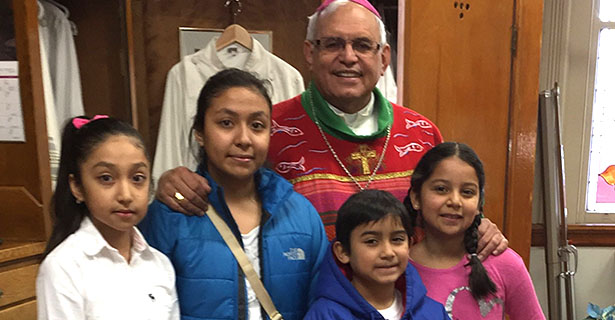Guatemalan Bishop comes to Cincinnati to mark feast

By Mary Bertolini
For The Catholic Telegraph
Why would an extremely busy bishop come to the United States just to help a small community celebrate a feast day?
When people flee their country, Guatemalan Bishop Alvaro Ramazzini explained recently during a visit to Cincinnati, they take only a bag of material belongings. But in their hearts, they take their deep faith.
Their greatest devotion, begun over 400 years ago, is El Señor de (the Lord of) Esquipulas. It’s part of their spiritual DNA. “I want to affirm that faith and that devotion,” he said. “Even Rome sees the importance of such affirmation. In 1996, Pope Paul II came to Guatemala to participate in the celebration of the 400th anniversary of this feast.”
This devotion began after a bright light caused a priest to examine the soil it hovered over on a country hillside in Esquipulas, a small nothing of a town at the time. When he dug in the dirt, he found a crucifix, and when people tried to enshrine it in a nearby church, it kept disappearing, only to be found again in its original spot. A basilica marks this scared place and shelters the special crucifix. Close to two million people, from Guatemala and neighboring countries, make a pilgrimage to Esquipulas every year to pray and give thanks for special favors received.
Bishop Ramazzini is no stranger to the United States or the Cincinnati archdiocese. He has come to the country numerous times to speak about immigration, human rights, fair trade, and economic inequality and to visit Guatemalan immigrants around the country, who number close to one million. In 2012, the bishop was the keynote speaker at Cincinnati’s Su Casa Annual Awards Dinner, and he was back this past January to help the Guatemalan community of St. Charles Borromeo (Carthage) celebrate the feast of Our Lord of Esquipulas.
Bishop Ramazzini led the Guatemalan diocese of San Marcos for 23 years, but left there because his challenges to the rich and powerful, in support of the poor who have no voice, brought him death threats. He now serves as the bishop of Huehuetananga in the country’s western highlands.
Challenges for the poor in Guatemala, especially the marginalized indigenous population, include barriers that keep them from owning land; drug trafficking; organized crime; child labor; child malnutrition; and human trafficking. Much of this is the result of government and business leaders failing to act with moral integrity.
“I was just in New York to help celebrate this feast in four different parishes, including St. Patrick Cathedral,” Bishop Ramazzini said. “It’s really catching on in the U.S. If it’s close to the hearts of the Guatemalans in their own country, how much more meaning it must have for the immigrants here. They know Jesus understands their pain. They feel a connection between the suffering of their lives and those of their Savior on the cross, who calms their anxieties and gives them hope in the face of extreme situations.”
The United States has its own poor, the bishop was quick to admit. Poverty, he said, doesn’t restrict itself only to immigrants. There is a poverty of spirit here as well, brought on by drugs, alcohol, abuse, and abandonment. This is where the Guatemalan immigrants can be a big help. “They bring with them a spiritual wealth,” he said, “a deep trust in God that they are more than willing to share.”
While Bishop Ramazzini comes to the United States to be in solidarity with his people, he has found that several organizations here have connected with his diocese of Huehuetananga to support local human development projects and to alleviate immediate medical and nutritional needs. “This option in favor of the poor is at the heart of the message Pope Francis gives in his “Joy of the Gospel,” the bishop said. “It’s good to see some American people living this message, but there is a need for many more to make this choice.”
Posted Feb. 25, 2015. This story is a TheCatholicTelegraph.com exclusive.









